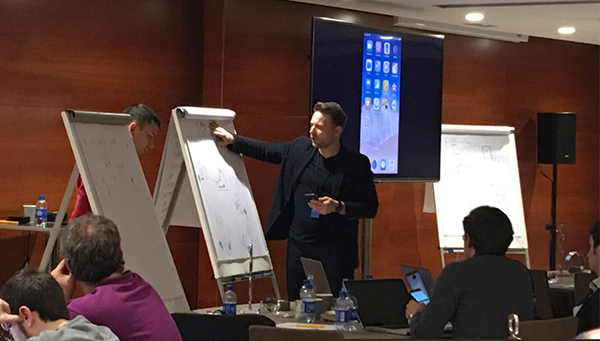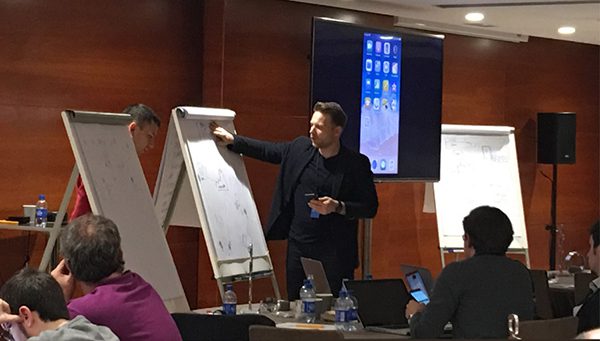Businesses are increasingly looking to enterprise mobility as an integral part of their digital transformation strategy. Many are even implementing a mobile-first approach for pivotal organizational roles, like field service personnel and sales people.
Gartner forecasts that by 2022, approximately 70 percent of all software interactions in the enterprise will occur on mobile devices.
SAP introduced the SAP Cloud Platform SDK for iOS to enable businesses to accelerate innovation of enterprise mobile apps for iOS devices, and recently added enhancements for controls and tighter integration. For developers and consultants with backgrounds in either SAP or iOS, the SDK has opened a new opportunity to build the next generation of applications combining the depth and intelligence of real-time enterprise data with the intuitiveness of a simplified mobile experience for increased workplace productivity. For more information, see SAP Cloud Platform SDK for iOS Powers Innovation.

Held in Barcelona on the eve of Mobile World Congress 2018, the world’s biggest trade fair event for the mobile community, the SAP Code Challenge for iOS Enterprise Apps provided a venue for developers to gain hands-on experience working with the tools of the SAP Cloud Platform SDK for iOS, as well as to learn best practices, get up to speed on the latest UI design guidelines, and ask questions to the SAP and Apple experts on site. The hackathon attracted developers from both the SAP ecosystem who wanted to build on their mobile skills, as well as developers form the iOS ecosystem who wanted to gain experience building enterprise apps.
Altogether, 37 developers from across Europe and the U.S. participated in the one-day event, organized by SAP and Apple. The group included both seasoned professionals and young careerists, working for tier-one consulting firms as well as small to midsize consultancies. Most had professional backgrounds in development or design, and had some prior experience working with both SAP and iOS technologies. Some developers from the Apple ecosystem had not had prior exposure to SAP and enterprise data.
The Challenge: Field Service Scenario Optimized for Device and User Experience
The hackathon challenge centered on a typical field service scenario for the telecommunications industry, wherein a field service worker must maintain a base station. Working in nine teams, the developers were tasked with coming up with a way to guide the worker to the location of the base station and then providing the relevant information at the site. They were given just six hours to build their applications. The teams started with an unfinished prototype that performed some of the data access into the SAP Cloud Platform, upon which they then had to build a user interface and add capabilities. The teams used SAP Fiori for iOS design language to create the UI.
Following a design thinking session in the morning, the teams set to work coding with SAP Cloud Platform mobile services in combination with Apple’s programming language, Swift, to create the device interface. All participants had an SAP Cloud account to access the demo data on an SAP HANA database. The challenge provided an opportunity for developers to combine the strengths of SAP and iOS to create an enterprise-grade mobile work solution – ready to go in just six hours.
“We got very deep questions already,” said Sami Lechner, product manager, SAP Mobile Services Unit, SAP, who provided SAP Cloud Platform and mobile support during the hackathon. “Every team is doing an end-to-end connection. People are tapping into real data through SAP Cloud Platform, syncing it to a device, and then putting a very nice UI on top of it. We’re showing them how to easily tap into the SAP world. If they go to a customer now who says ‘this is the format of data I want,’ they know exactly what the customer wants and they can give it to them.”
At the end of the day, each team was given six minutes to pitch their app to their peers, first by demonstrating the flow on a flip chart and then with a demo of the app. Feedback was based on practical criteria, such as the user experience of the app; innovative ideas around the use of the technology; and viability of the concept in a business context.
In the limited time given, each team was able to produce a complete end-to-end app. Although the teams took varied approaches to guiding the field service worker to the site, most took advantage of the graphical map interfaces available on iOS and relied on the SAP Fiori for iOS design language to display data in the UI. One team went the extra mile by enhancing their app with QR code reading capabilities and video-enabled chat.
“Feedback has been very positive,” said Holger Fritzinger, head of Mobile Solution Management at SAP. “The participants liked the idea of getting an app built in such a short time. This is what we also want to also drive home. Besides learning from the challenge itself, the event is also about being able to ask questions of the SAP and iOS experts on hand as well as leveraging the approach for their customer projects.”
Follow Up by SAP Developer Relations
After the success of the hackathon, the follow up is just as important as the event itself, say members of SAP Developer Relations. They intend to maintain one-on-one contact with the participants to see how their projects are developing, as well as to provide additional enablement sessions on topics like how to integrate more SAP Leonardo services into apps and how to further modify back-end data.
“We’ll be reaching out to see how else we can help the participants develop their skills,” says Ian Thain of SAP Developer Relations. “A lot of them are just starting their journey.”


Leave A Comment?
You must be logged in to post a comment.